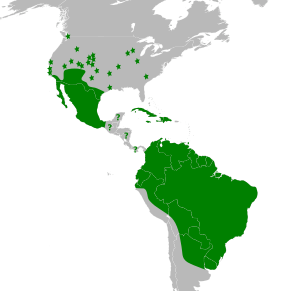Big free-tailed bat facts for kids
Quick facts for kids Big free-tailed bat |
|
|---|---|
 |
|
| Conservation status | |
| Scientific classification | |
| Genus: |
Nyctinomops
|
| Species: |
macrotis
|
 |
|
| Synonyms | |
|
|
The big free-tailed bat (Nyctinomops macrotis) is a fascinating bat species. It lives in South, North, and Central America. These bats are known for their unique tails. Their tails stick out from their flight membrane.
Contents
Discovering the Big Free-tailed Bat
This bat was first described in 1839. A British scientist named John Edward Gray officially named it. He gave it the scientific name Nyctinomus macrotis. The first bat studied was found in Cuba.
What Does the Big Free-tailed Bat Look Like?
This is the biggest bat in its group, Nyctinomops. Its forearm is about 60 millimeters (2.4 inches) long. Each bat weighs around 20.6 grams (0.7 ounces). That's about the weight of four quarters! Its wingspan is quite wide. It measures between 417 and 436 millimeters (16.4 to 17.2 inches).
The bat's fur is shiny. Its color can change a lot. It can be light reddish-brown. It can also be dark brown or even blackish. This bat has 30 teeth in total.
How Does the Big Free-tailed Bat Fly?
Scientists study the shape of its wings. They think this bat flies very fast. Its flight speed could be over 40 kilometers per hour (25 miles per hour). Imagine how quickly it can zoom through the air!
Where Does the Big Free-tailed Bat Live?
This bat lives in many countries. You can find it across North, Central, and South America. Some of the countries where it lives include:
- Argentina
- Brazil
- Canada
- Colombia
- Cuba
- Dominican Republic
- Ecuador
- French Guiana
- Guyana
- Haiti
- Jamaica
- Mexico
- Suriname
- the United States
- Venezuela
It might also be found in Uruguay. Sometimes, bats are found far from their usual homes. This is called being a "vagrant." Bats found in Canada and some U.S. states like Iowa and Kansas are often vagrants. However, the big free-tailed bat lives regularly in Texas, California, Nevada, and Utah. These bats can live in many places. They have been found from sea level up to 2,600 meters (8,500 feet) high.
Is the Big Free-tailed Bat in Danger?
The IUCN checks on animals. As of 2015, they say the big free-tailed bat is a "least-concern species." This is the lowest level of worry. It means the bat is not in danger right now. This is because it lives in a very large area. Its population is not dropping quickly. Also, there are likely many of these bats around.
See also
 In Spanish: Murciélago cola de ratón grande para niños
In Spanish: Murciélago cola de ratón grande para niños


